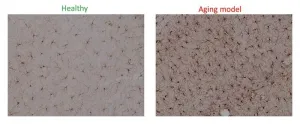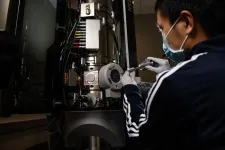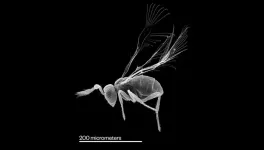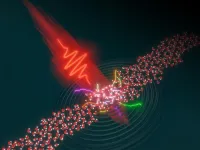(Press-News.org) Normal aging is usually associated with a decline in memory, although it is unclear what factors play a role. In a new study, researchers studied specific interneurons, which serve as communication centers that connect other neurons, in the regions of the brain that are important for learning and memory.
Increasing age places people at risk, whether it is because of a normal decrease in cognitive ability or due to postoperative cognitive disorders. In the latter, the deficits can persist for many months after surgery especially when the patients are older than 60. Unfortunately, the underlying cellular mechanisms that cause these impairments are largely unknown.
Previous studies have shown that the region of the brain that is associated with learning and memory—the hippocampus—decreases in volume with age. Additionally, the levels of the molecule -aminobutyric acid, or GABA, and some of the interneurons that release it are also affected.
In the present study, the researchers focused on the hippocampal interneurons in a specific region, called the hilus of the dentate gyrus, that are characterized by their expression of somatostatin. This hormone has the ability to counteract the effects of growth hormones elsewhere in the body.
“In the past, other researchers have found that one of the differences between cognitively impaired and unimpaired rats was that the former had a lower number of somatostatin-positive interneurons in the hilus of the dentate gyrus,” said Uwe Rudolph (GNDP), a professor of comparative biosciences. “We wanted to further investigate whether a loss of these neurons is really responsible for cognitive deficits, and whether it could thus serve as a model of aging in the hippocampus.”
The researchers decreased the numbers of somatostatin-positive interneurons in the hippocampus of mice by using a toxin. They injected this toxin into the dentate hilus, so that the toxin would only be expressed in the somatostatin-positive interneurons, killing approximately 50% of these cells. Starting 3 weeks later, they conducted behavioral studies to test the learning abilities and memory of the mice.
The mice underwent three types of tests: whether they could remember and differentiate novel objects from familiar ones, navigate mazes using their short-term memories, and use their spatial learning to find a hidden platform in a pool of water. In all three cases, the mice that had decreased levels of somatostatin-positive interneurons struggled compared to those that did not receive the toxin.
The researchers also looked for changes in cellular signals that occur due to lower levels of somatostatin-positive interneurons. To do so, they focused on the microglia, which are immune cells that are among the first to respond when something goes wrong in the brain.
“We looked at microglial activation, which is a hallmark of the inflammation that is associated with aging and memory impairment,” said Rajasekar Nagarajan, a postdoctoral researcher in the Rudolph lab. “We saw increased activation of microglia in the hippocampus of the mice that were injected with the toxin, even outside of the dentate gyrus.”
In addition to determining the status of microglia, the team measured a protein called brain-derived neurotrophic factor, which is active in the hippocampus and plays a role in long-term memory. They found that there were lower BDNF levels in the hippocampal tissue of the toxin-injected mice. Furthermore, the researchers also found that these mice had fewer hippocampal dendritic spines, which are critical for learning and memory.
Unsurprisingly for the researchers, the results seen with the toxin-injected mice were essentially the same as with aged mice that were 18-19 months old and had not been injected with the toxin.
“18 months-old mice correspond to an age of approximately 60 years in humans. It roughly fits the time point at which we know that people more frequently develop neurocognitive deficits in response to surgery and anesthesia,” Rudolph said. “Our results have shown that using this toxin to reduce the number of somatostatin-positive interneurons is sufficient to cause effects that resemble cognitive deficits in aging.”
The researchers are excited that they can use these techniques to investigate aging-related defects without waiting for the mice to grow old, which is an expensive and time-consuming undertaking. “We will be using this method as a model to test which experimental compounds can be used to prevent or reverse both age-related and post-operative cognitive impairments,” Nagarajan said.
The paper “Genetic Ablation of Dentate Hilar Somatostatin-Positive GABAergic Interneurons is Sufficient to Induce Cognitive Impairment” was published in Molecular Neurobiology and can be found at https://doi.org/10.1007/s12035-023-03586-3. The study was funded by the NIH.
END
Specific interneurons are important in aging-associated cognitive decline, study finds
2023-09-28
ELSE PRESS RELEASES FROM THIS DATE:
New study provides evidence for more effective brain-based treatment of chronic back pain
2023-09-28
A new study in JAMA Network Open may provide key answers to how to help people experiencing chronic back pain.
The study, published today, examined the critical connection between the brain and pain for treating chronic pain. Specifically, they looked at the importance of pain attributions, which are people’s beliefs about the underlying causes of their pain, to reduce chronic back pain severity.
“Millions of people are experiencing chronic pain and many haven’t found ways to help with the pain, making it clear that something is missing in the way we’re diagnosing and treating people,” said the ...
A new twist on rechargeable battery performance
2023-09-28
RICHLAND, Wash.—For decades, researchers have assumed that the inevitable filmy buildup on electrodes inside rechargeable batteries is the driver of performance loss. Now, we know that view is backward.
The buildup of mossy or tree-like structured lithium metal deposits on battery electrodes is not the root cause of performance loss, but rather a side effect. The first direct measurement of the electrical properties at the boundary between the solid electrode and the liquid electrolyte inside a rechargeable battery is reported today in Nature Energy.
The study, led by a research team at the Department of Energy’s Pacific Northwest National Laboratory, shows that the so-called ...
Pharmacist-led intervention can improve medication adherence among Latinos with type 2 diabetes
2023-09-28
UCLA-led research suggests that diabetes control can significantly improve for Latinos when a pharmacist implements an intervention that addresses these patients’ barriers to medication adherence.
In this pharmacist-led intervention, pharmacists reviewed the patients’ lab results, vital signs, and barriers to adherence. They then used this information to design a personally-tailored intervention to boost medication adherence and optimize the treatment regimen.
The study is the first to evaluate a collaboration between pharmacist and physicians aimed at improving diabetes care in a large healthcare system among Latino patients, said study lead Dr. Kimberly Narain, ...
Decoding the complexity of Alzheimer’s disease
2023-09-28
CAMBRIDGE, MA -- Alzheimer’s disease affects more than 6 million people in the United States, and there are very few FDA-approved treatments that can slow the progression of the disease.
In hopes of discovering new targets for potential Alzheimer’s treatments, MIT researchers have performed the broadest analysis yet of the genomic, epigenomic, and transcriptomic changes that occur in every cell type in the brains of Alzheimer’s patients.
Using more than 2 million cells from more than 400 postmortem brain samples, the researchers analyzed how gene expression is disrupted as Alzheimer’s progresses. They also tracked changes in ...
Accelerating sustainable semiconductors with ‘multielement ink’
2023-09-28
Key takeaways:
Scientists have developed “multielement ink” – the first “high-entropy” semiconductor that can be processed at low-temperature or room temperature.
Multielement ink could enable cost-effective and energy-efficient semiconductor manufacturing.
The new semiconducting material could accelerate the sustainable production of next-gen microelectronics, photovoltaics, solid state lighting, and display devices.
Semiconductors are the heart of almost every ...
Researchers create first-ever map of a single animal’s early visual system
2023-09-28
Neuroscientists at the Flatiron Institute in New York City and their colleagues have made a big breakthrough using one of the world’s smallest brains.
Using an ion beam, an electron microscope and a lot of patience, the neuroscientists mapped out the entire early visual system — from the eyes that take in light to the neurons processing the information — for a parasitic wasp smaller than a grain of table salt. The feat marks the first time scientists have fully reconstructed such a system at the synaptic level from a single specimen of any animal species, the neuroscientists report ...
Study reveals more depression in communities where people rarely left home during the COVID-19 pandemic
2023-09-28
Key Takeaways
In a survey-based study of US adults, those living in communities in which most people seldom left home at certain times during the COVID-19 pandemic were more likely to report symptoms of depression
The link remained strong even after considering COVID-19 activity, weather, and county-level economics
Accounting for state-level pandemic restrictions only modestly attenuated the association
BOSTON – Higher levels of depressive symptoms have been reported during the COVID-19 pandemic compared with other times in history, and as much as three times higher than prior to the ...
Intense lasers shine new light on the electron dynamics of liquids
2023-09-28
An international team of researchers from the Max Planck Institute for the Structure and Dynamics of Matter (MPSD) in Hamburg and ETH Zurich has now demonstrated that it is possible to probe electron dynamics in liquids using intense laser fields and to retrieve the electron mean free path – the average distance an electron can travel before colliding with another particle. They found that the mechanism by which liquids emit a particular light spectrum known as the high-harmonic spectrum is markedly different from the one in other phases of matter like gases and solids. The team’s findings open the door to a deeper understanding of ultrafast dynamics in liquids.
Using ...
Study helps explain how COVID-19 heightens risk of heart attack and stroke
2023-09-28
In some patients, infection with the pandemic virus SARS-CoV-2 can trigger a dangerous immune response in hardened fatty deposits (plaques) lining the heart’s largest blood vessels, a new study shows.
The findings are based on the body’s immune system, which evolved to destroy invading microbes but also drives disease when triggered in the wrong context. Doing so brings on a set of responses termed inflammation, including swelling, which results as immune cells and signaling proteins home in on infection sites. ...
People who use alternative medicine favor risk and novelty, and distrust science
2023-09-28
Over 40 per cent of Canadians have used at least one risk-associated alternative health-care treatment in the past 12 months, says a new UBC study published in PLOS One.
The researchers explored alternative health-care therapies where the proven benefits do not justify the risks involved. They found that people who access these therapies tend to be wealthier, like novelty and taking risks, and are also more likely to distrust conventional medicine.
The multidisciplinary study between UBC School of Nursing and the University of Alberta Health Law Institute involved a survey of 1,492 Canadians ages 16 and over ...



